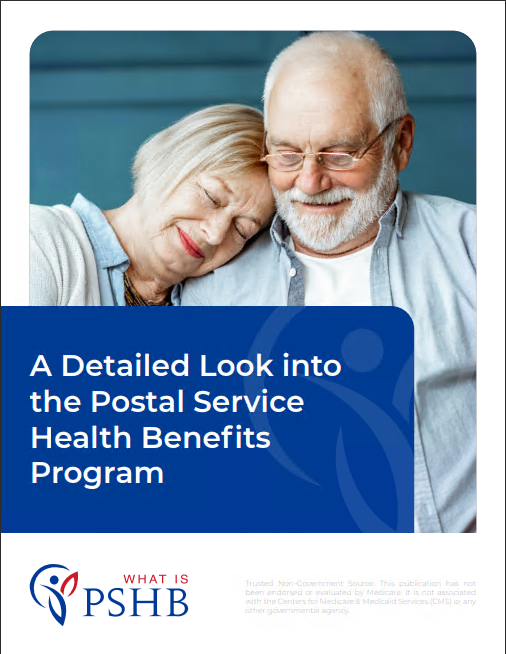Key Takeaways
-
The Postal Service Health Benefits (PSHB) program officially replaces FEHB for USPS employees and annuitants in 2025, so it’s crucial to understand your new options before Open Season.
-
Medicare enrollment decisions can affect your PSHB coverage, especially if you’re retired or close to retirement age.
Understanding the PSHB Program
If you’re part of the USPS family—whether you’re an active employee or a retiree—2025 brings big changes. The Postal Service Health Benefits (PSHB) program is now the official health insurance program for USPS workers and annuitants, replacing FEHB. But don’t worry, you still have plenty of choices—and some important decisions to make.
Let’s walk through what you need to know to stay ahead of the curve.
What Is the PSHB Program?
The PSHB program is a new federal health insurance offering tailored specifically for USPS employees, retirees, and their eligible family members. This program was created as part of the Postal Service Reform Act of 2022 and takes full effect in 2025.
Here’s what makes PSHB different:
-
It operates separately from the Federal Employees Health Benefits (FEHB) program.
-
All eligible USPS employees and retirees must transition to PSHB.
-
Medicare-eligible retirees are required to enroll in Medicare Part B to stay in a PSHB plan (with a few exceptions).
Why It Matters Right Now
The transition is not just a name change. You’ll see new plan options, new rules for Medicare coordination, and a new structure for Open Season. This means your old plan under FEHB might not automatically carry over—unless you’re paying attention.
What USPS Employees Should Look For
Whether you’re just starting your USPS career or you’re a year away from retiring, there are some important PSHB-specific things to keep on your radar.
Coverage Categories
You’ll choose from the same coverage tiers you had under FEHB:
-
Self Only
-
Self Plus One
-
Self and Family
But within those categories, you’ll notice:
-
Different plan designs
-
Updated provider networks
-
Cost-sharing structures (deductibles, coinsurance, and copays)
Government Contribution
The government continues to pay about 70% of your premium, just like under FEHB. That means you’re responsible for the rest—so it’s still worth comparing what you’re getting for your share of the cost.
High-Deductible vs Low-Deductible Plans
If you prefer lower premiums and can manage higher out-of-pocket costs, a high-deductible plan might work for you. On the other hand, if you visit the doctor regularly, a low-deductible plan could save you more in the long run. Review the plan brochures carefully before choosing.
What Retirees Need to Consider
For retirees or those planning to retire soon, PSHB comes with a few extra wrinkles you shouldn’t ignore.
The Medicare Part B Requirement
If you turn 65 in 2025 or beyond and are retired, you must enroll in Medicare Part B to stay enrolled in a PSHB plan. If you retired before January 1, 2025, and aren’t already enrolled in Part B, you’re exempt from this rule.
This rule has major implications:
-
Added Monthly Cost: You’ll pay the standard Medicare Part B premium, which in 2025 is $185/month.
-
Potential Benefits: Some PSHB plans offer incentives like reduced deductibles and copays for those enrolled in both PSHB and Medicare.
Prescription Drug Coverage
Medicare-eligible retirees enrolled in PSHB will automatically be enrolled in an EGWP (Employer Group Waiver Plan) for prescription drugs. This replaces traditional Part D coverage but gives you similar or better protection, often with lower out-of-pocket costs.
Out-of-Pocket Protections
The PSHB program follows a cap on annual out-of-pocket spending:
-
$7,500 for Self Only
-
$15,000 for Self Plus One and Self and Family
That cap includes deductibles, coinsurance, and copays for in-network services—but not your monthly premium.
Getting Ready for Open Season
Open Season happens every year from November to December. During this window, you can:
-
Switch plans
-
Change enrollment types
-
Add or remove eligible family members
What You Should Do Before Open Season
-
Review your current plan to see if it still meets your needs.
-
Evaluate your medical needs for the upcoming year.
-
Check if your doctors and prescriptions are covered under the new PSHB options.
-
Compare costs for different plan levels (but don’t just go with the lowest premium).
Coordinating PSHB With Medicare
This is where things can get tricky but potentially rewarding. If you’re retired and eligible for Medicare, enrolling in both PSHB and Medicare Part B can lower your overall out-of-pocket spending.
Why Pairing Them Can Help
When you have both:
-
PSHB becomes your secondary coverage.
-
Many PSHB plans will waive or reduce your deductibles and copays.
-
Your prescription drug coverage is handled through a Medicare Part D EGWP plan, which can be more generous.
Don’t Skip Part B Without a Good Reason
Unless you’re exempt, skipping Part B will disqualify you from enrolling in PSHB. If you’re not sure whether this applies to you, get in touch with a licensed agent to clarify your situation.
What Happens If You Do Nothing?
If you’re already enrolled in FEHB and you qualify for PSHB, you’ll be automatically moved into a similar plan under the PSHB program. But here’s the thing: “similar” doesn’t mean “the same.”
That’s why you should still:
-
Review the new PSHB plan brochure.
-
Make sure it aligns with your current doctors and medications.
-
Double-check that the plan suits your expected health care needs for the year.
PSHB and Life Events
Outside of Open Season, you can make changes to your PSHB coverage only if you experience a Qualifying Life Event (QLE). Some common QLEs include:
-
Marriage or divorce
-
Birth or adoption of a child
-
Death of a spouse or dependent
-
Loss of other health coverage
The time window for making a change due to a QLE is usually 60 days from the event.
Staying Informed Without Getting Overwhelmed
We get it. Insurance talk can feel like reading a foreign language. That’s why it helps to break it down into manageable actions:
-
Read the official PSHB plan brochures
-
Keep an eye out for Open Season announcements
-
Use comparison tools (if available through USPS or OPM)
-
Talk to a licensed agent if you feel stuck
You don’t have to figure it all out in one sitting, but you do have to stay on top of it to avoid mistakes that could cost you later.
Make the Most of Your PSHB Choices
When you understand the PSHB program, you’re in a much better position to make choices that actually fit your life. Whether you’re trying to save money, coordinate with Medicare, or simply avoid surprise bills, the time to act is now.
Don’t leave this decision on autopilot. Get in touch with a licensed agent listed on this website to walk through your options and find the best fit for your situation.






